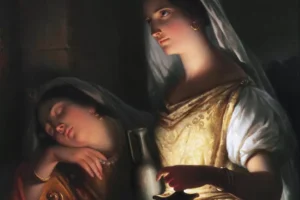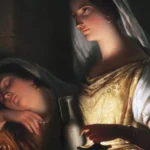Matthew 7:13-14 “Enter by the narrow gate. For the gate is wide and the way is easy that leads to destruction, and those who enter by it are many. For the gate is narrow and the way is hard that leads to life, and those who find it are few.”
Which word, if you were to summarize the Bible in a single word, would it be?
Now, that’s a tall order. I mean, I’m confident you could think of a number of words that would apply to the Bible. Jesus certainly comes to mind. So do faith, repentance, grace, and salvation.
And you would be correct. All these words define the Bible. I’m sure you could envision even more.
But what is the all-inclusive story and unifying theme that God is trying to convey in the Bible? What is He attempting to accomplish and communicate through His word?
I apologize, but this is not a trick question. In fact, it’s the very first request of the most familiar prayer in existence – The Lord’s Prayer of Matthew 6:9-10 “Our Father in heaven, hallowed be your name. Thy Kingdom come…”
That’s it! In a word, Christ defines and summarizes His immediate and most pressing request in the Lord’s prayer – His desire to bring about the Kingdom. And as we’ll see, the Bible is all about God’s efforts to draw humanity into His Kingdom. Over and over again. Unfortunately, it also shows man’s persistence in rejecting God’s Kingdom efforts.
Kingdom unifies the Bible. What does the Garden of Eden have to do with the Exodus? They are both Kingdom efforts. So is Christ’s incarnation and, ultimately, the Millennium and New Heaven and Earth; all Kingdom efforts and necessary because men continue to reject God’s will. Fortunately, God never gives up on men.
Let’s look at some of these Kingdom efforts in a little more detail.
The Garden of Eden
We can begin with Genesis 2:8-9: “And the LORD God planted a garden in Eden, in the east, and there he put the man whom he had formed. And out of the ground the LORD God made to spring up every tree that is pleasant to the sight and good for food. The tree of life was in the midst of the garden, and the tree of the knowledge of good and evil.”
1. Environment: The Garden of Eden was described as a paradise, a place of perfection and harmony where everything was created to be good. It was a reflection of God’s perfect Kingdom, where He was the ruler, and everything was in perfect alignment with His will.
2. God’s Presence: In the Garden of Eden, Adam and Eve had direct communion with God. They walked and talked with Him without any barriers or separation. This signifies the close relationship between God and humanity and how He desires to establish His Kingdom where He dwells among His people.
3. Dominion and Stewardship: God gave Adam and Eve the responsibility to rule and have dominion over all the creatures and the earth itself. This illustrates God’s intention for His people to be co-rulers and stewards in His Kingdom. It shows that God’s Kingdom involves taking care of His creation and fulfilling the purpose for which humans were created.
4. Order and Righteousness: The Garden of Eden was a place of perfect order and righteousness, where God’s will was fully expressed. This reflects God’s desire for His Kingdom to be a place where His will is done perfectly and where righteousness prevails.
5. Growth and Development: God created the Garden of Eden as a place for Adam and Eve to grow spiritually and develop their relationship with Him. In His Kingdom, God desires His people to continually grow in knowledge, wisdom, and love for Him.
Overall, the Garden of Eden was God’s initial attempt to establish His Kingdom on earth, a place of perfect harmony, direct communion with God, and the fulfillment of His will. We were supposed to live here; unfortunately, we know the end of the story: Adam and Eve disobeyed God, and Genesis 3:23-24 records, “Therefore the LORD God sent him out from the garden of Eden to work the ground from which he was taken. He drove out the man, and at the east of the garden of Eden, He placed the cherubim and a flaming sword that turned every way to guard the way to the tree of life.”
The Exodus
The Exodus of Moses from Egypt also shows similarities to establishing God’s Kingdom. In Exodus 23:20-21 God promises, “Behold, I send an angel before you to guard you on the way and to bring you to the place that I have prepared. Pay careful attention to him and obey his voice; do not rebel against him, for he will not pardon your transgression, for my name is in him…”
1. Environment: The Exodus journey ultimately led the Israelites to the Promised Land, a place flowing with milk and honey. This land symbolizes the inheritance and blessings that God has in store for his people in His Kingdom.
2. God’s Presence: During the Exodus, God’s presence was manifested in various ways, such as the pillar of cloud and fire leading the Israelites, the provision of manna and water, and the sanctuary in their midst. This reflects God’s desire to dwell among His people and be present in His Kingdom.
3. Dominion and Stewardship: Just as Adam and Eve were in a state of harmony and perfection before the fall, the Israelites were initially free; however, they became enslaved and oppressed by the Egyptians. In Exodus, God delivered the Israelites from their bondage, symbolizing God’s desire to free his people from the bonds of sin and establish His Kingdom of freedom and redemption.
4. Order and Righteousness: After their liberation from Egypt, God established a covenant with the Israelites, giving them the Ten Commandments and various laws and statutes to govern their conduct and relationship with Him. This represents the establishment of a divine order and moral code in God’s Kingdom.
5. Growth and Development: In the Exodus, God raised Moses as the leader to guide and deliver the Israelites out of Egypt. This demonstrates God’s intention to have leaders and prophets to govern and guide His people in His Kingdom, working under His divine authority.
The Exodus of Moses shows similarities to the establishment of God’s Kingdom, including deliverance from bondage, divine leadership, the establishment of a covenant and laws, God’s presence among his people, and the promise of a land of blessing and fulfillment. As is typical of humanity, however, the Jews rejected God over and over. Initially, their disbelief and even Golden Calf idolatry resulted in a denial of the promised land, only to be realized by Josuha, with the next generation entering the promised land as discussed in Joshua 1:2, where it states, “Moses my servant is dead. Now therefore arise, go over this Jordan, you and all this people, into the land that I am giving to them, to the people of Israel.” The cycle of sin, oppression, and deliverance continued, only to be repeated over and over again and even beyond Christ’s first coming.
The Incarnation
The dawn of the church age did not commence until the Jews again rejected the Kingdom announced in Mark 1:15, which stated, “The time is fulfilled, and the kingdom of God is at hand; repent and believe in the gospel.” The incarnation of Christ as fully man and fully God on earth also reveals several similarities to the establishment of God’s Kingdom.
1. Environment: Jesus declared that the Kingdom was at hand and encouraged people to repent and believe in the good news. This reveals the central message of God’s Kingdom and His desire for people to acknowledge and enter into it. Jesus invited people to become citizens of God’s Kingdom through faith in Him. He emphasized the need for repentance, belief, and surrender to Him to enter into and experience the blessings and benefits of God’s Kingdom.
2. God’s Presence: Just as God dwelled among his people in the Garden of Eden and during the Exodus, Jesus, the Son of God, came to live among humanity during his incarnation on earth. He brought the presence of God’s Kingdom with Him, and even when Christ departed, He filled His believers with the Holy Spirit, demonstrating God’s desire to be intimately present with His creation.
3. Dominion and Stewardship: Jesus exercised divine authority and leadership during His ministry. He taught with authority, healed the sick, cast out demons, and forgave sins. His actions showcased the establishment of God’s reign and His role as the ruler in the Kingdom of God.
4. Order and Righteousness: Jesus performed various miracles, healings, and supernatural signs during his time on earth. These acts highlighted the power and authority of God’s Kingdom breaking into the world, demonstrating the restoration of divine order and the defeat of evil.
5. Growth and Development: Through His incarnation, Jesus came to offer redemption and salvation to humanity. He accomplished this through His sacrificial death on the cross and subsequent resurrection, reconciling humanity to God and providing a way for people to enter God’s eternal Kingdom.
In Acts 2:23, where the apostle Peter speaks to a Jewish crowd, He states the result of Christ’s Kingdom effort through His incarnation, “This Jesus, delivered up according to the definite plan and foreknowledge of God, you crucified and killed by the hands of lawless men.” Once again, the world rejects God’s Kingdom, but He does continue a way: salvation through faith alone in Christ alone.
The Millennium and New Heavens and New Earth
The final establishment of God’s Kingdom, the Millennium (the thousand-year reign of Christ), and New Heaven and New Earth also contain similarities to the previous examples, as announced in Revelation 20:4 “Then I saw thrones, and seated on them were those to whom the authority to judge was committed. Also I saw the souls of those who had been beheaded for the testimony of Jesus and for the word of God, and those who had not worshiped the beast or its image and had not received its mark on their foreheads or their hands. They came to life and reigned with Christ for a thousand years.” The final Kingdom follows this in Revelation 21:1: “Then I saw a new heaven and a new earth, for the first heaven and the first earth had passed away, and the sea was no more.”
And just like Eden’s tree of life, Revelation 22:2 discusses, “Through the middle of the street of the city; also, on either side of the river, the tree of life with its twelve kinds of fruit, yielding its fruit each month. The leaves of the tree were for the healing of the nations.”
1. Environment: The Millennium, the New Heaven, and the New Earth promise eternal life and blessings for those who are part of God’s Kingdom. They depict a state of everlasting joy, peace, and fulfillment, where all the promises and blessings of God are fully realized.
2. Divine Presence: God’s presence is fully manifested and experienced in both periods. The Millennium and the New Heaven and New Earth are characterized by the direct reign of Christ, and entail God’s dwelling among his people. God’s presence signifies the complete establishment of His Kingdom and the fulfillment of His desire to dwell with His creation.
3. Dominion and Stewardship: Both the Millennium and the New Heaven and New Earth involve the restoration and renewal of creation. They depict a state of perfect harmony, where the effects of sin and corruption are completely removed, and everything is restored to its original intended state. This signifies the fulfillment of God’s promises and the establishment of His Kingdom of righteousness where redeemed man finally and ultimately assumes stewardship and leadership in His Kingdom.
4. Order and Righteousness: In the Millennium, New Heaven, and New Earth, righteousness and justice prevail. There is no more sin, evil, or injustice. God’s Kingdom is fully established, where his perfect will is carried out, and where righteousness reigns.
5. Growth and Development: In both the Millennium and the New Heaven and New Earth, Christ is depicted as the reigning King. His authority and rule are central to both periods, indicating the establishment of God’s Kingdom in its ultimate and perfected form. The growth of the redeemed is depicted in Revelation 20:6, which states, “…they will be priests of God and of Christ, and they will reign with him for a thousand years.”
Overall, the establishment of the Millennium and the New Heaven and New Earth are similar to all the previous efforts to establish God’s Kingdom. They involve the reign of Christ, restoration and renewal, righteousness and justice, divine presence, and the promise of eternal life and blessings. These periods represent the fulfillment of God’s plan for His Kingdom and the ultimate realization of His purposes for creation.
It should be noted that since the beginning, deceased believers have resided in an intermediate state of conscious blessing and union with God called the Kingdom of Heaven to await the eternal Kingdom of New Heaven and New Earth (Rev 21:1), as Peter desires in 2 Peter 3:13 “But according to His promise we are looking for New Heavens and a New Earth, in which righteousness dwells.”
It is not without one last Satanic-influenced effort to reject God’s Kingdom in the Millennium, one last hail-Mary attempt in Revelation 20:7-10 which details the final battle. “And when the thousand years are ended, Satan will be released from his prison and will come out to deceive the nations … and they marched up over the broad plain of the earth and surrounded the camp of the saints and the beloved city, but fire came down from heaven and consumed them, and the devil who had deceived them was thrown into the lake of fire… forever and ever.”
Conclusion
And there you have it, the all-inclusive story and unifying theme that God expresses in the Bible in a single word – the establishment of His Kingdom.
Do you prefer to be part of the many who reject God and enter by the wide gate, or would you desire to be part of the few who accept Christ and His free gift of the Kingdom and enter by the narrow gate?
You may have given up on Him, but He has not given up on you. As 2 Peter 3:9 promises, “The Lord is not slow to fulfill his promise as some count slowness, but is patient toward you, not wishing that any should perish, but that all should reach repentance.”








